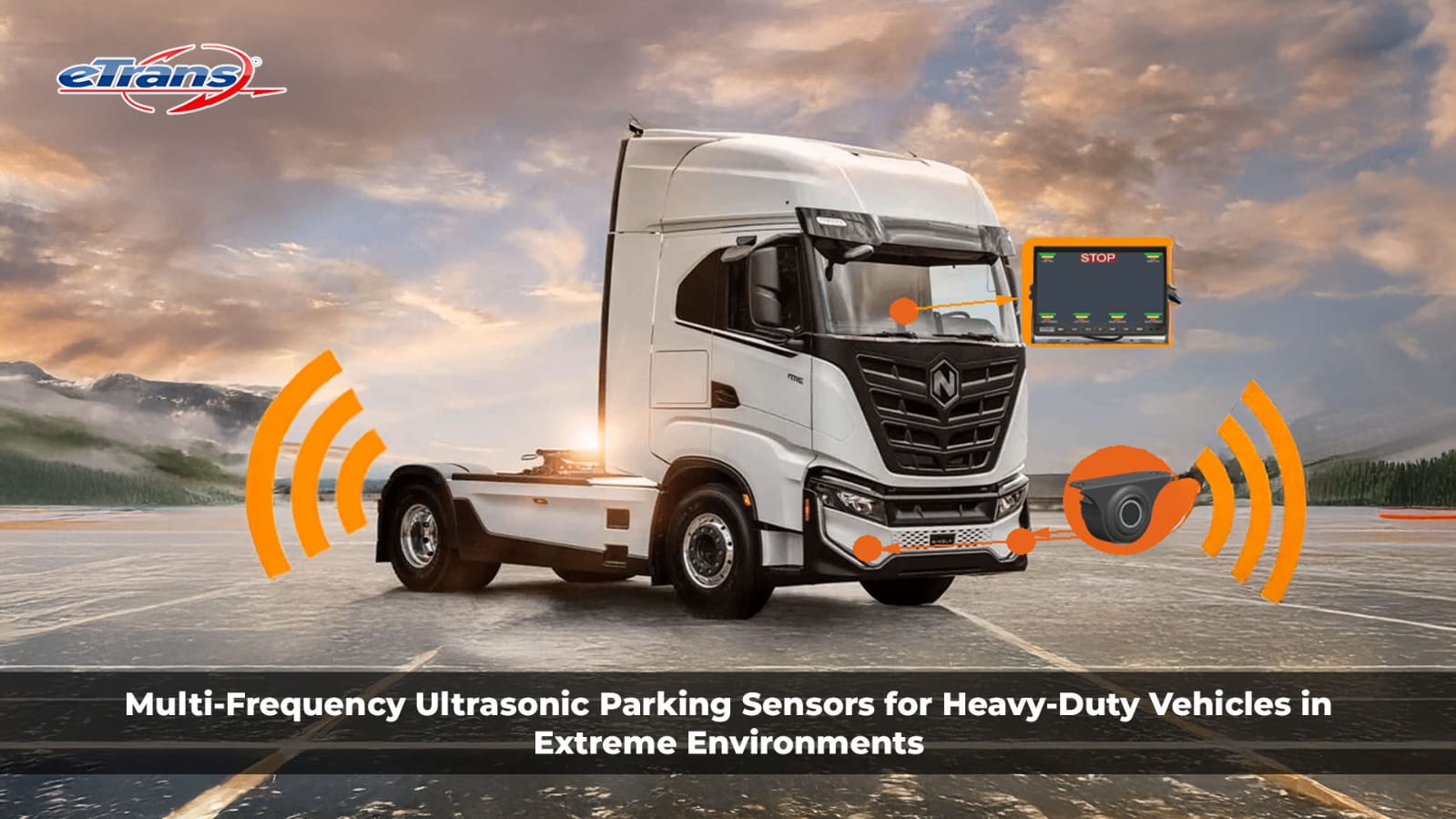If you’ve ever tried to park a 40-ton mining truck in a dust storm or back up a farm harvester in knee-deep mud, you know the pain. Visibility drops, mirrors get coated, and even cameras become useless when lenses are covered. In such conditions, heavy-duty vehicle parking sensors can be a fleet manager’s best friend—but only if they’re tough enough to handle it. Standard single-frequency sensors often lose accuracy in harsh environments, giving unreliable readings or going completely blind.
This is where multi-frequency ultrasonic parking sensors come in. Designed for heavy-duty vehicles, they use multiple sound wave frequencies to detect obstacles even when mud, grime, or extreme temperatures would throw traditional sensors off. By switching between or combining different frequencies, these systems cut through interference, reduce false alarms, and improve detection accuracy. And with ruggedised builds like ultrasonic sensors with an IP69K rating, they can survive high-pressure washing, corrosive chemicals, and intense vibration.
In this guide, we’ll explore how these sensors work, why they outperform single-frequency setups, and what design choices make them reliable in the toughest conditions. We’ll also look at calibration techniques, integration with ultrasonic sensors in vehicle telematics, and real-world use cases in mining, agriculture, and construction. If you’re managing a fleet that operates in extreme conditions, this could be the technology that keeps your vehicles and crews safer while cutting downtime.
Why Multi-Frequency Matters in Harsh Conditions?
Single-frequency sensors are fine for clean, predictable environments like city streets. But in heavy-duty operations, sensors face dust, mud, water, snow, and temperature extremes. Low-frequency signals (like 40 kHz) travel farther and penetrate through airborne dust and mud films, but they sacrifice precision. High-frequency pulses (like 160 kHz) give pinpoint accuracy for close-range obstacles but can get dampened by environmental interference.
Multi-frequency ultrasonic sensors combine the best of both worlds. In practice, they can use low-frequency waves for initial detection at long range, then switch to high-frequency pulses for close-in manoeuvres. This method accounts for uneven obstacle surfaces and counteracts temperature-induced changes in speed of sound.
For example, in a dusty mining pit, a low-frequency scan can first identify a rock pile at 5 meters, while a high-frequency pass confirms the exact edge to within a few centimetres. This layered detection by ultrasonic parking sensors significantly reduces false positives and improves driver confidence.
Signal Propagation & Frequency Trade-offs
Sound waves behave differently in air depending on frequency. Low frequencies propagate further and are less affected by airborne particles, making them ideal for obstacle detection in poor visibility. However, they produce wider beams and less precise location data. High frequencies offer a narrower beam and faster echo return, allowing for more accurate distance measurement, but they are more easily absorbed or scattered.
Frequency multiplexing sensors dynamically adapt by selecting the optimal frequency or combining them in a single reading. They also use adaptive ultrasonic thresholding to adjust sensitivity when interference is detected. This means that if mud partially covers the sensor, the system compensates by amplifying or filtering certain frequency bands to keep readings reliable.
Ultrasonic sensor signal processing ensures that echoes are interpreted correctly, even in noisy environments. Modern units integrate sensor echo quality diagnostics to assess the clarity of returns, flagging degraded performance before a complete failure occurs.
Rugged Housing and Material Design
An ultrasonic parking sensor is only as good as its housing in extreme operations. Ultrasonic sensor ruggedisation for heavy-duty use often includes:
● Stainless steel or reinforced polymer housings.
● Full epoxy potting to prevent vibration damage.
● IP69K-rated sealing for resistance to high-pressure steam cleaning.
● Corrosion-resistant coatings for salt, chemicals, and fuels.
● Flush-mounted designs to prevent debris buildup.
A mud-resistant ultrasonic transducer design keeps the sensing element functional even after splashes. In agriculture, sensors may encounter acidic fertilisers, while in mining, they face abrasive slurry. Durable housings ensure the sensors last the vehicle’s service life, reducing replacement costs and downtime.
Calibration Strategies for Multi-Frequency Systems
Setting a single sensitivity level is not enough to calibrate a multi-frequency ultrasonic sensor. Each frequency needs individual calibration for:
● Temperature compensation (the speed of sound deviates with the air temperature).
● Surface reflectivity adjustments (wet mud reflects differently than dry gravel).
● Environmental noise filtering.
Using IO-Link connectivity or advanced ultrasonic sensor firmware tuning, technicians can remotely adjust thresholds, frequency weighting, and beam patterns without removing the sensor. Ultrasonic sensor calibration also involves testing under simulated field conditions, ensuring reliable readings before deployment.
For fleets, this remote calibration capability means less downtime. Instead of pulling a sensor from a bulldozer for bench testing, technicians can fine-tune it from the operations centre.
System Integration and Sensor Fusion
A standalone ultrasonic sensor is good, but its real potential shines in a sensor fusion setup. Data from multi-frequency ultrasonic sensors can be incorporated into ultrasonic telemetry integration platforms, combining with radar and camera inputs. This fusion creates a comprehensive environmental model that supports:
● Rear collision avoidance.
● Blind-spot detection.
● Automated low-speed manoeuvres.
In mining trucks, combining deep-beam ultrasonic detection with radar allows detection of both static and moving obstacles. Ultrasonic-radar data fusion increases reliability in dust or fog where cameras fail. Integration with telematics-enabled mobility systems also allows fleet managers to track sensor health, usage patterns, and performance trends.
Case Examples: Mining Trucks, Agricultural Combines & Construction Equipment
In mining, trucks often work in zero-visibility dust clouds. Multi-frequency ultrasonic sensors help detect boulders, pit walls, or even workers approaching a vehicle, despite heavy airborne particles.
Agricultural combines face thick mud and crop residue. Here, dust-tolerant proximity sensors maintain accurate readings even after hours in muddy fields. For construction cranes in rainy climates, temperature compensation ensures that readings remain stable across rapid temperature shifts from hot engines to cold winds.
In all these cases, features like ultrasonic sensor beam tuning and auto-gain control adjust to changing environmental conditions in real time, reducing false alarms and improving safety.
Design Challenges and Sensor Maintenance
Even with advanced tech, challenges remain. Mud or ice can clog sensor ports. False echoes can occur in environments with a lot of reflective surfaces. Frequency interference between closely placed sensors can reduce performance.
To address these issues, best practices include:
● Flush-mounting sensors to reduce buildup.
● Installing self-cleaning covers or wipers.
● Scheduling periodic washdowns.
● Rotating frequency patterns to avoid interference.
For extreme-duty fleets, maintenance planning should consider sensor replacement intervals based on hours worked, not just mileage.
Conclusion
In extreme environments, multi-frequency ultrasonic sensors give fleets a significant edge. They combine long-range detection with high-resolution accuracy, resist environmental interference, and integrate seamlessly into vehicle telematics systems. Their rugged designs withstand high-pressure cleaning, corrosion, and vibration, making them ideal for mining, agriculture, and construction.
By investing in the right sensor technology and maintenance strategy, fleet operators can improve safety, reduce accidents, and cut downtime. In industries where a single collision can halt operations and cost thousands, that’s an investment worth making.
Frequently Asked Questions
1. How do multi-frequency ultrasonic sensors differ from standard parking sensors?
They use multiple sound wave frequencies for better accuracy and reliability in harsh conditions, unlike single-frequency models that struggle with interference.
2. Are IP69K-rated sensors necessary for all heavy-duty vehicles?
Not always, but for vehicles exposed to high-pressure cleaning or corrosive environments, they’re highly recommended.
3. Can ultrasonic sensors work in complete darkness or fog?
Yes, ultrasonic sensors are unaffected by light conditions and can operate in darkness, fog, or dust.
4. How often should ultrasonic sensors be calibrated?
Calibration frequency depends on operating conditions, but remote calibration can be done anytime via telematics systems.
5. Can ultrasonic sensors integrate with existing fleet telematics?
Yes, many models support integration through standard protocols, enabling data sharing and remote diagnostics.



